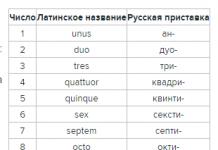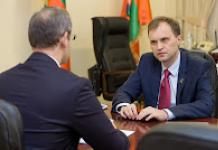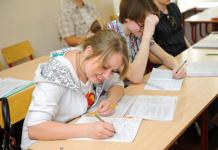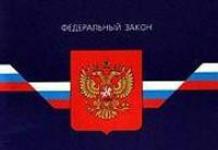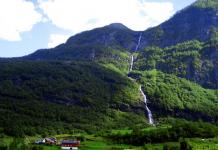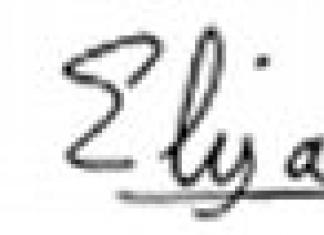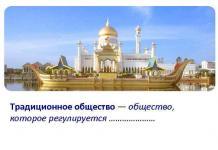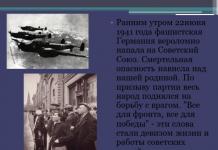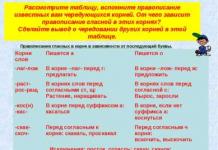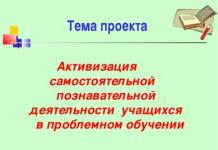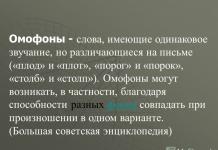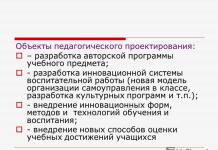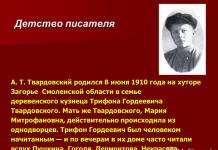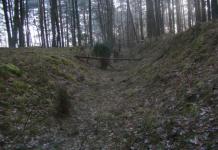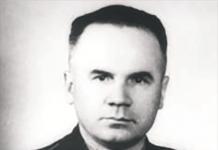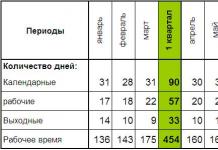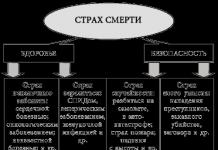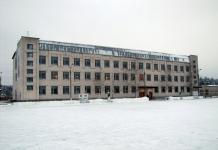Prague Academy fine arts- This State University, which is the oldest art school in the Czech lands.
The Academy offers master's and doctoral studio programs in the field of fine arts and allows you to get higher education in the following specialties:
- painting,
- sculpture,
- drawing And Graphics,
- multimedia production,
- new funds mass media,
- restoration works of art painting and sculpture,
- Architectural Engineering.
The Academy conducts artistic, scientific, research activities which promotes continuous learning. Also, the Academy of Fine Arts is an important cultural institution and, in the spirit of tradition, participates in the formation and development of culture and society.

Features of studying at the Academy
Many well-known artists were teachers of the academy. And its graduates have been shaping the Czech visual culture for two centuries. Periods of progressive learning alternated with phases of ideological dictatorship and loss of contact with modern developments.

Until 1990, teaching at the academy was conservative. After the reform, new studios were added to the classical studios - multimedia, conceptual, sculpture-installation, drawing. Both traditional and experimental methods are used in teaching.
Lectures, studios and workshops of teachers are focused on the problems of contemporary art, which is the basis of the concept of teaching students and graduate students. Today, about 300 students, 30 doctoral students study at the Academy, the teaching staff consists of 58 people. Exhibitions of student works are held annually at the Academy Gallery.

Location of the Academy
The Academy of Fine Arts is located in five buildings. The main building is a cultural monument. It was built in Art Nouveau style in 1897-1903 according to the project of Vaclav Rostlapil especially for the Academy. Jan Kotera became the author of its interior.
The School of Architecture is located in a separate building near the main building. It was built in 1922-1924 according to the design of Jan Kotera and Josef Gochar. It houses the School of Architecture, the Academy's Research Institute and the New Media Studio. The building is also a cultural monument.
The building of the modern gallery is located in the exhibition complex in Prague Holesovice. It was built in 1891 as part of a nationwide jubilee exhibition designed by Antonin Wihl. It houses: a graphic workshop, workshops for the restoration of paintings, sculpture, sculpture and graphics studios. There are also evening drawing hours for free listeners. A stone tablet with words of gratitude to Josef Hlávk is attached above the door of the building.

Studio Chalon on Vinohrady (“Shalon”) is a place where guest teachers and consultants of the Academy give master classes. This is the personal studio of the famous sculptor Ladislav Shalon. It has large and small studios, the salon of the Slavic hut of Dusan Yurkovic, the lobby, the occult basement.
The studio on Zaitsova Street ("Zaitsovka") was built in 1902 for an exhibition of works by Auguste Rodin during his visit to Prague. Here it is preparatory school drawing and modeling for first-year students. The building is a cultural monument.
The Academy of Fine Arts in Prague is a modern educational institution that not only carefully preserves traditions Czech school painting, sculpture and architecture, but also tries to solve the problems facing contemporary fine arts.

History of the Academy
The idea of creating the Academy of Fine Arts in Prague appeared at the height of the Baroque era. In 1709-1711, a group of Prague artists attempted to create an academy, but it was unsuccessful. In 1796, during the period of state support for culture and education, the "Society of Patriotic Friends of Art" was created. First they founded an art gallery, and then a drawing academy. On September 10, 1799, an imperial decree was issued on the creation of a new educational institution, which began its work in 1800.
Soon, a graphics workshop and a school of landscape painting were added to the drawing academy. In the middle of the 19th century, lectures on theoretical subjects of fine arts and the teaching of architecture were included in the academic curriculum.
The fundamental reform of the academy was carried out by the artist Julius Marzhak. He suggested including well-known artists such as Vojtech Ginajs and Václav Brozik in the teaching staff. He founded the first school of sculpture under the direction of Josef Myslbek and achieved the nationalization of the academy in 1896.

The range of educational possibilities of the academy increased in 1910 with the addition of the Max Schwabinsky School of Graphics and the architectural studio of Jan Kotera. In 1926, the academy was the first in Czechoslovakia to adopt the Charter high school arts. In 1945, she opened a school for the restoration of works of art by Bohuslav Slansky.
In 1968, the educational reforms carried out did not live up to expectations. And only in 1990, under the leadership of the new rector Milan Knizhak, the concept and structure of the educational institution completely changed and the teaching staff changed. A school for the restoration of sculpture was opened, in 1991 a school for new media.
Since January 1, 1998, the Academy of Fine Arts in Prague has been a public university.
Prague Academy of Fine Arts one of the most prestigious universities educational institutions specializing in the training of artists. This is the oldest academy Czech Republic founded at the end of the 18th century. The university provides training in two educational programs: magistracy and postgraduate study. The term for masters is 6 years, except for the specialty "Architecture", which takes 4 years. The term of study for postgraduate students lasts for 3 years. Within the framework of the master's program, there are 8 specialties, among which are not only classical areas, but also modern programs, such as, for example, "new media". As part of the postgraduate study, applicants have the opportunity to choose one of the three available specialties. It should be noted that this university provides training only on Czech.
Specialties offered under magistracy:
Intermedial creativity;
Painting (free creativity);
Architectonic art;
Sculpture - restoration of works of sculpture;
Drawing, graphics;
New media;
Sculpture (free creativity);
Painting - restoration of paintings.
PhD students have the opportunity to study the following specialties:
Art;
Architectonic art;
Restoration of works of fine art.
The entrance examination is carried out in two stages. At the first stage, the commission considers the applicant's portfolio. At the second stage, applicants will be asked to pass a creative exam. Detailed information about the order of admission, entrance exams and their content is posted on the official website of the university:
The Academy of Fine Arts in Prague is the very first art university in the Czech Republic. The Academy was founded by decree of Emperor Franz I in 1799 on the initiative of the Society of Patriots Friends of Art. The first director of the university was the artist Josef Begler. During its existence, the Academy focused on various areas of painting - landscape, romantic, and later - historical themes. In 1896, the Academy became the property of the state, a department of sculpture, architecture and graphics appeared. In 1926 she was awarded the status of "higher art school". In 1947, Boguslav Slansky opened a restoration school of European significance at the Academy.
Currently, about 300 students study here, currently the rector is Tomasz Vanek.
Faculties and study programs
There are no faculties at the university, graduate studies after school last 6 years (there is no division into undergraduate and graduate programs), however, there are specialties of the magistracy for those who already have a bachelor's degree, in this case the training lasts 3 years.
1. Program of fine arts (master's degree after school - 6 years), specialties:
- Painting
- Sculpture
– Sculpture
- Graphics and drawing
- Graphic arts
- Drawing
- Intermedia and new media
– Intermedial creativity
– New media
- Restoration of works of art
– Restoration of paintings and polychrome plastics
– Restoration of sculptures
2.Master's programs after bachelor's degree:
Fine arts (Master's degree - 3 years), specialties:
- architectural creativity
- free art
– Painting
– Sculpture
– Figure sculpture and medals
- Graphic arts
- Drawing
– Intermedial creativity
Admission

For all specialties, you must pass a creative exam, which consists of two parts. The main criterion for admission is the demonstration of artistic talent, motivation, a sufficient general cultural overview and the ability for further creative development and theoretical reflection of one's own creativity.
The first part of the exam takes place without the presence of the student; submitted portfolio is evaluated admission committee which includes all leading educators. Selected candidates go to the second (practical) round entrance examinations which is carried out directly at the university.
Portfolio:
Master's after school (6 years)
Painting
- 15 original works must be submitted
Graphics and drawing
- It is necessary to provide 15-30 of any works
Intermedia and new media
- You can submit both original works of art - drawings, sketches, objects, etc., as well as various documentation (photographic documentation, audio and video documentation, etc.), The number and volume of submitted works: no more than 15 pieces, size no more than 150 cm. In addition, works using sound, digital images, light, photographs, etc. are accepted.
Sculpture
- It is necessary to provide a portrait model (material, for example, plaster) and one free composition, any other sculptural works in the form of photographic documentation and drawings up to A0 in size.
Restoration of works of art
1. Restoration of painting and polychrome plastic
- A minimum of 15-30 works must be submitted, which must include realistic drawings of portraits and figures, color work in any technique, own copies of the work, and any own color work.
2. Restoration of sculptures
- It is necessary to provide one spatial realization in solid material, other sculptural works in the form of photographic documentation and drawings up to A0 in size. It is also necessary to provide a restoration report or part of it in the form of photographic documentation up to A2 format, in which it is necessary to indicate what exactly the candidate’s work consisted of, describe his cooperation in working with other artists.
Master's degree after bachelor's degree:
architectural creativity
- It is necessary to provide works (own and joint), of which there must be at least 5 own works and at least one in the original
free art
- It is necessary to provide 3-10 any original works
The second part of the exam is practical:
- 1st day - drawing or plastic modeling on a real model
- 2nd day - a composition on a given topic, made in any technique, a test for a general cultural overview
- 3rd day – free composition in any technique
- 4th day - a special assignment from the corresponding teacher, at the same time interviews with individual candidates
For all specialties, it is also necessary to provide a certificate in the Czech language at level A2, a short resume and a motivation letter.
You can also see the admissions training courses Czech language in Prague.
The Academy strives to preserve the best of its renowned traditions, which include the development of talent and the promotion of freedom, ingenuity and imagination, including intellectual collaboration between faculty and students, their identification with universities, and the productive use of the Academy as a whole. Today, the academy constantly analyzes the quality of its faculties, which allows it to take places in the international arena.
The Academy of Performing Arts will continue to play a role in shaping the Common National and Cultural Identity, through its students, to ensure the continuity of cultural identity. Despite the fact that in 2010 the Academy of Performing Arts in Prague celebrated its sixty-fifth anniversary, it will remain young, lively and full of energy.
Faculties:
Theater Department (DAMU)
The Theater Department of the Academy of Performing Arts in Prague is a modern arts education center aimed at liberal education creative individuality, the ability to combine their knowledge of theatrical practice, processes and styles of creative experiments. The most prominent personalities of Czech theatrical life and teachers from abroad teach here. The faculty has a large number of external contacts, as well as internships within the EU outside of it. Graduates of the faculty are employed in the leading theaters in the Czech Republic, working in independent theater groups, applied as theater artists, theater critics, directors, teachers in the broad sense of the authors.
Program and specializations
The Master's program in Fine Arts (M8206) is a 6-year full-time study program aimed at in-depth training in the arts, as well as talent development. The only exception is the specialization "Architecture" (Architektonická tvorba), which requires a bachelor's degree in this specialization for admission, and also takes 4 years of study.
This Master Program includes the following specializations and studios/schools:
- Specialization "Painting" (Malířství / volná tvorba)
- painting studio I / school of Jiří Sopek
- Painting Studio II / Vladimir Skrepl School
- painting studio III / school of Michael Rittstein
- Painting Studio IV / Martin Mainer School
- Specialization "Sculpture" (Sochařství / volná tvorba)
- Sculpture Studio I / Lukáš Rittstein School
- Sculpture Studio II / School of Jindřich Zeithamml
- Figurative Sculpture and Medal Studio/Vojtěch Míča School
- Specialization "Drawing/Graphics"
- drawing studio / school of Jiří Petrbok
- graphics studio I / school of Jiří Lindovsky
- graphics studio II / school of Vladimir Kokola (Vladimír Kokola)
- Specialization "Intermedia" (Intermediaální tvorba)
- Intermedia Studio I / School of Milena Dopitova
- Intermedia Studio II / School of Dušan Zahoransky and Pavla Scerankova
- Intermedia Studio III / School of Tomáš Vaňek
- Specialization "New Media"
- New Media Studio I / Tomáš Svoboda School
- New Media Studio II / Anna Daučíkova School
- Specialization "Painting - restoration of paintings"
- Studio for the restoration of works of fine art and polychrome plastics / Karla Stretti School
- Specialization "Sculpture - restoration of sculptural works"
- Sculpture Restoration Studio / Petr Siegl School
- Specialization "Architecture"
- architecture studio / school of Emil Přikryl
Criteria and conditions for admission to the Academy of Fine Arts in Prague
The main criterion for admission to the AVU master's program is the presence of talent, motivation to study, sufficient general cultural erudition and the ability to further creative development and theoretical reflection of personal work (? in the original - teoretické reflexe vlastní tvorby).
Also an important condition is completed secondary education, and entrance exams can be taken at last year school / college education (not necessarily after graduation). As mentioned earlier, in order to enter Architecture, you must already have a higher education (bachelor's or master's degree) in this field.
In exceptional cases (if the applicant has an extraordinary talent), you can enter the Academy of Fine Arts in Prague without having a secondary education. However, at the same time, upon completion of the master's program, no academic title is awarded (? in the original: v takovém případě však není nárok na udělení akademického titulu po absolutoriu magisterského studia).
Also, an important condition for admission is knowledge Czech language, and most importantly - a certificate of passing an exam in Czech for any level is NOT required. Exams are taken in Czech, so that knowledge of the language will be tested. The requirements for foreign applicants are exactly the same as for the Czechs.
Applying for AVU Entrance Exams
- The application form can be found on the website of the academy from November 1.
- You can submit a maximum of 2 applications for 2 different specializations. In this case, the applications must indicate the priority of these specializations (1 and 2), and payment must be made only for the application with the highest priority specialization (1).
- Once completed, each application must be printed and personally signed.
- The following must be attached to the application(s):
- short resume and motivation letter
- confirmation of secondary (or higher in the case of Architecture) education, or a certificate from the school stating that the applicant is studying in the last year of study
- confirmation of payment of the fee of 580 CZK for participation in the exams
Applications and the above documents can be brought in person to the student department of the Academy of Fine Arts in Prague or sent by registered mail until 30.11.2015 to the address: Akademie výtvarných umění v Praze Studijní oddělení ul. U Akademie 4 psc(index) 170 22 Praha 7 The main thing is to send before 11/30/2015, and when the letter reaches the addressee - it is not particularly important. Therefore, a letter / parcel must be stamped with the date of departure.
Be careful, because If an incorrectly completed application or an incomplete package of documents may deprive you of the right to participate in the exams.
If you need help in filing an application and preparing documents (including assistance in nostrification) - - and I will be happy to help.
In response to the submission of the application, by the end of the calendar year, the applicant will receive by registered letter (to the address of permanent residence or the address for correspondence indicated in the application), harmonograms of the admission process (exam schedule, etc.). However, I'm not sure if they send this document abroad.
Description of the admission process (2 steps)
Admission takes place in January and February in 2 stages. The first stage is carried out without the personal participation of the applicant: the commission, which includes all the leading teachers of AVU, evaluates the previously submitted work (portfolio). Some of the applicants with the best works proceeds to the second stage of admission, which takes place in the form of a talent exam in the respective studios of the Academy.
Reception of homework (portfolio)
The portfolio must be submitted in the main building of the Academy in the so-called Gallery (Galerie AVU) on 12-14.01.2016 from 9:00 to 17:00. All works (each of them) must be marked with the surname and name of the applicant and the studio(s) where the application(s) were submitted. Also, along with the work, you must provide a list of these works on a separate sheet. In addition, it is advisable to mark the work with a personal number, which you will receive on the university website when applying. If homework is divided into different folders, then this should also be indicated on the work list sheet. Works can be submitted both in folders or between boards. At the same time, works wound in rolls will not be accepted (with the exception of specializations in restoration and architecture). The maximum size of works is 150 cm x 150 cm, the minimum is not limited. The actual assessment of the work will be held on 18. - 20.01.2016. The results will be announced on 25.01. 2016.
Works do not have to be carried personally, you can do it through a trusted person. For this you, again, can for help.
Painting 15 original works in any technique and genre
Drawing, Graphics 15-30 works
sideshow You can provide as original works - drawings, paintings, objects, etc. - as well as photo documentation, sound and video documentation, etc. Number of works - up to 15 pieces.
New media Concepts of works using sound, digital images, light, photographs, etc. Works in classical disciplines (drawing, plastic, etc.) are also possible.
Sculpture One modeling portrait work (material - gypsum, for example) and one spatial composition of your choice. Other sculptural works must be submitted in the form of photographic documentation and a drawing in maximum A0 format (on boards).
Painting - restoration Minimum 15-30 works, including realistic studio drawings of portraits and figures (roll attached to the boards (?) (role připojená k deskám)), color works in any technique, copies of works in drawing.
Sculpture - restoration One spatial realization in dense material, the rest of the sculptural works in photographic documentation and drawings in A0 format maximum - in boards. It is also possible to provide a restoration report and photo documentation in maximum A2 format, reflecting the restoration process or part of this process. Optionally, you can also describe the scope of your work / your contribution to a particular restoration. Works in rolls are not accepted.
Architecture Personal (minimum 5 pieces, one of them in the original) and joint work.
Return of works to applicants who do not pass to the second stage
The works will also be returned to the Gallery in the Academy building on January 27 – 29, 2016 from 9:00 to 17:00
If the applicant cannot pick up the work on his own, then this can be done by a trusted person (for example). After the issuance period has passed, the Academy ceases to be responsible for the safety of the remaining works, and after 2 weeks they will probably be destroyed.
Stage 2 - format and content of the talent exam
The practical talent exam will take place on February 8 – 11, 2016 in the main building of the AVU or in the building of the Modern Gallery (Moderní galerie), depending on the location of the individual studios.
It will consist of the following parts:
- day - drawing or plastic according to the real model
- day - compositions on given topics in free technique, a test on general cultural development
- day - free composition in free technique
- day - a special test task, at the same time interviews are held with individual applicants
In the case of the specializations "Architecture" and "Restoration of objects of art", the exam can be further modified to suit their specifics. Based on the complex results of the admission process, the leading teachers of the respective studios will compile lists of the best applicants, which will be discussed at the general meeting. The resulting list will be passed on to the rector, who will make the final decision.
Within one week after the end of the talent exam, applicants will be able to personally assess the result of the assessment of the leading teacher of the relevant specialization, having come to the student department in work time. Lists will also be published on the website and in the lobby of the main building of the Academy on February 16, 2016.
Return of works to applicants who entered the second stage
The works of applicants (portfolio) who entered the second stage of the admission process and took part in the talent exam will be issued individually by assistants of individual studios on February 22 - 26, 2016. To do this, you need to personally contact the assistant and agree on the date and time of the meeting. Again, after the deadline, the Academy will no longer be responsible for the safety of the remaining works, and they will be destroyed after 2 weeks. If you cannot pick up the work yourself, I can do it by proxy. .
End of introductory program
The rector decides on admission to study at the Academy of Fine Arts. The decision will be prepared within 30 days after passing the talent exam and sent to the applicant by registered mail. It will contain, in case of non-acceptance, instructions on how to file an application for review of the decision (appeal). If the applicant did not indicate his address, the result will be posted in the university hall. An appeal can be filed through the student department to the rector within 30 days of receiving the result. Up to 15 days after the end of admission, the Academy will publish a corresponding report on the website.
Number of places for new students for 2016/2017
For this academic year, the Academy plans to accept approximately 45 applicants. The final number will be known after admission.
That, in fact, is all the information indicated in the official document. I tried to translate everything almost verbatim.
If you do not understand something - ask your questions in the comments or in person.


